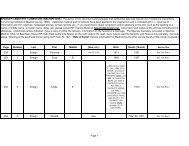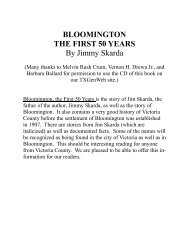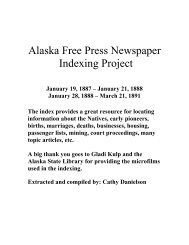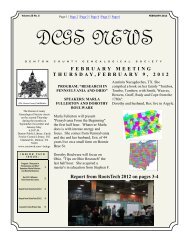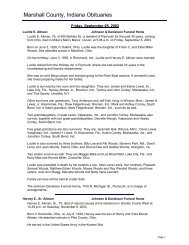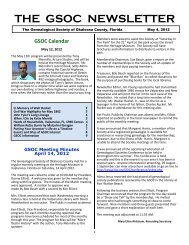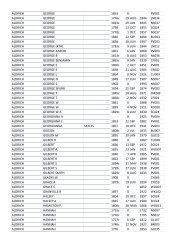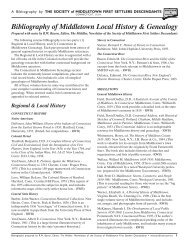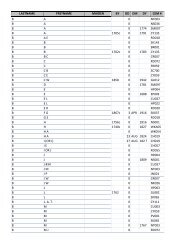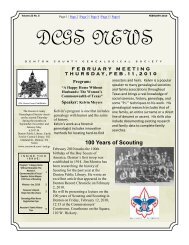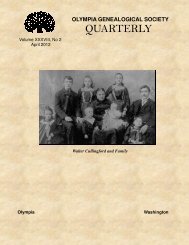Indian population in the United States and Alaska. 1910 - RootsWeb
Indian population in the United States and Alaska. 1910 - RootsWeb
Indian population in the United States and Alaska. 1910 - RootsWeb
Create successful ePaper yourself
Turn your PDF publications into a flip-book with our unique Google optimized e-Paper software.
"<strong>the</strong> <strong>in</strong>quiry with, respect to occupations at <strong>the</strong><br />
Thirteenth Census called for a statement as to <strong>the</strong><br />
"trade or profession of, or particular k<strong>in</strong>d of work<br />
done" by each person engaged <strong>in</strong> ga<strong>in</strong>ful labor, <strong>and</strong><br />
also as to <strong>the</strong> "general nature of <strong>in</strong>dustry, bus<strong>in</strong>ess, or<br />
establishment" <strong>in</strong> which <strong>the</strong> person worked. The<br />
statistics of <strong>the</strong> occupations of <strong>Indian</strong>s reported <strong>in</strong><br />
this volume are limited to ga<strong>in</strong>ful workers 10 years of<br />
age <strong>and</strong> upward. The term "ga<strong>in</strong>ful workers," as<br />
used <strong>in</strong> <strong>the</strong> pr<strong>in</strong>ted <strong>in</strong>structions to enumerators <strong>and</strong><br />
<strong>in</strong> this report, <strong>in</strong>cludes all workers, except women<br />
do<strong>in</strong>g housework <strong>in</strong> <strong>the</strong>ir own homes, without salary<br />
or wages, <strong>and</strong> hav<strong>in</strong>g no o<strong>the</strong>r employment, <strong>and</strong><br />
children work<strong>in</strong>g at home, merely on general household<br />
work, on chores, or at odd times on o<strong>the</strong>r work.<br />
Sufficiency oj <strong>the</strong> occupation returns.—In general, <strong>the</strong><br />
occupations of <strong>the</strong> <strong>Indian</strong>s were not so carefully retm-ned<br />
by <strong>the</strong> enumerators as were <strong>the</strong> occupations<br />
of <strong>the</strong> whites. No doubt this was due largely to <strong>the</strong><br />
greater difficulty of <strong>the</strong> task, but <strong>in</strong> some cases, pos-<br />
sibly, it was due to <strong>the</strong> <strong>in</strong>efficiency or carelessness of<br />
<strong>the</strong> enumerators. In <strong>Alaska</strong> <strong>the</strong> enumeration was <strong>in</strong><br />
<strong>the</strong> w<strong>in</strong>ter. In some of <strong>the</strong> outly<strong>in</strong>g sparsely populated<br />
districts it was necessary to use as enumerators<br />
persons of very limited educational qualifications.<br />
Moreover, <strong>the</strong> <strong>Indian</strong> <strong>population</strong> of <strong>Alaska</strong> is <strong>in</strong> large<br />
part illiterate. Under <strong>the</strong>se conditions enumeration<br />
was at best difficult. But, because of <strong>the</strong> fact that <strong>the</strong><br />
<strong>Alaska</strong> <strong>Indian</strong>s are ma<strong>in</strong>ly hunt'ers, trappers, fishermen,<br />
<strong>and</strong> deer herders <strong>and</strong> keepers, <strong>the</strong>re was little<br />
danger of <strong>the</strong> enumerators confus<strong>in</strong>g occupations.<br />
However, some of <strong>the</strong>se <strong>Indian</strong>s may have been missed<br />
entirely, <strong>and</strong> probably o-<strong>the</strong>rs were returned as ga<strong>in</strong>fully<br />
occupied when <strong>the</strong>y should not have been. In<br />
edit<strong>in</strong>g <strong>the</strong> returns both for <strong>the</strong> <strong>United</strong> <strong>States</strong> proper<br />
<strong>and</strong> for <strong>Alaska</strong> <strong>the</strong> most improbable cases of <strong>Indian</strong>s<br />
returned as ga<strong>in</strong>fully occupied were rejected; but,<br />
notwithst<strong>and</strong><strong>in</strong>g this, it is probable that too many of<br />
<strong>the</strong> <strong>Indian</strong>s are reported as ga<strong>in</strong>ful workers. This is<br />
certa<strong>in</strong>ly true <strong>in</strong> <strong>the</strong> case of particular tribes, where<br />
<strong>the</strong> proportion ga<strong>in</strong>fully employed exceeds 60 per<br />
cent.<br />
Number <strong>and</strong> 'proportion occupied.—Table 101 shows,<br />
for <strong>the</strong> <strong>United</strong> <strong>States</strong> <strong>and</strong> for <strong>Alaska</strong>, <strong>the</strong> number of<br />
<strong>Indian</strong>s engaged <strong>in</strong> ga<strong>in</strong>ful occupations <strong>in</strong> comparison<br />
with <strong>the</strong> total <strong>Indian</strong> <strong>population</strong> <strong>and</strong> with <strong>the</strong> <strong>Indian</strong><br />
<strong>population</strong> 10 years of age <strong>and</strong> over, for both sexes<br />
<strong>and</strong> for each sex separately, at <strong>the</strong> censuses of <strong>1910</strong><br />
<strong>and</strong> 1900, respectively.<br />
(250)<br />
OCCUPATIONS.<br />
Tab



